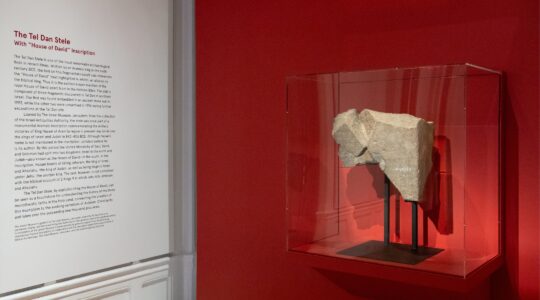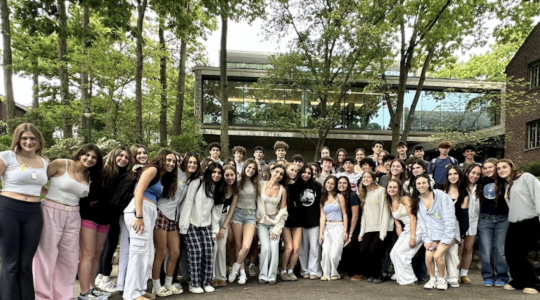In two new exhibits at the National Arts Club, the Russian American Federation is celebrating ties between Russia and the Jewish people. The main exhibit in the Grand Gallery of the exclusive Gramercy Park club is devoted to the Odessa artist Yosef Ostrovsky. The secondary show is “The Times of a Great Dream: American Artists Gift to the Jewish Autonomous Region in the USSR,” which revisits an exhibit that took place over 75 years ago.
Ostrovky’s Jewish Cycle artworks, which were produced between the 1970s and 1990s, are mainly portraits, still lifes and genre scenes. The works were created “in the atmosphere of fear and threats from the government,” according to the artist’s son, Meir. “He could not officially exhibit these works and only could do this underground. Thank God he was not prosecuted or arrested for that.”
Most are painted in watercolor and oil paint, mainly in muted tones; Ostrovsky preferred a matte finish. Though holding on to his heritage was difficult, Ostrovsky tried to follow Jewish traditions in the Ukraine and he painted a number of folkloric Jewish scenes: “The Doubter, a man with a beard and cap shrugs his shoulders, his hands are opened, asking why; “The Jew with a Book,” depicts a man wearing a yarmulke holding a small book, perhaps a siddur, in both of his hands.
Ostrovsky’s people have exaggeratedly long faces, making them appear to be serious, a bit melancholic. The influence of the artists he admired most such as Rembrandt, Bruegel, Picasso and Chagall is evident.
In a charming watercolor called “Courtyard in Jerusalem” from 1992, Ostrovsky allows us to peer through a rounded archway into a peaceful space evoking the holy city through its beige stones and low green bushes. Ostrovsky also veered into surrealism with “Perplexity,” a pencil drawing from 1987, and abstraction with “Composition,” from 1992.
Ostrovsky was born in 1935 in Shepetovka, a small town in the Ukraine. He moved to Odessa to study art at the Odessa State Art Academy and lived there until he immigrated to Israel in 1989. He was a successful artist, recognized in both the Ukraine and Israel; he became the chief artist of Sderot. His son, Meir, a rabbi, is the president of the Jewish Day School in Dnepropetrovsk, Ukraine, where he was sent by Chabad in Israel.
“Look at my father’s works, and now look at me. Do you see some similarity? I became a real product of my father’s vision,” Meir said. Once Ostrovsky moved to Israel, he began signing his artwork in Hebrew. “It was a dream of all his life and he was proud to become an Israeli citizen and tried to learn and speak Hebrew as fast as he could,” recounted Meir. “He wanted to absorb as much of Jewish culture as he could.”
Ostrovsky felt that his art could be appreciated by all. He often said, “Eternal themes concern everyone. The language of art and feeling knows no borders. The more deeply you penetrate the soul of your own nation, the more understandable your art becomes to other nations.”
Downstairs at the National Arts Club, there is an exhibit of work devoted to what would be a Russian-Jewish Promised Land (the show had a very short run and closed June 7). This Jewish district, the Birobidzhan Autonomous Region, was meant to be a refuge from anti-Semitism and a place where Jewish culture could be preserved.
In the 1930s an exhibit was planned in support of Birobidzhan, and participants included Jews, international anti-fascists and artists of Russian origin. Staged in Boston and in New York, “A Gift to Birobidzhan,” a collection of over 200 artworks, traveled next to Moscow in 1937, and was intended for the state museum of Birobidzhan, however Josef Stalin ended this hope as he had begun murdering Jewish leaders in Birobidzhan, and severely curtailing the rights of Jews. A number of the works were destroyed in World War II, but 74 remain, the majority of which are prints.
“The Time of a Great Dream” features most of these surviving works — the others were in too poor condition to be exhibited. There is a lithograph by famed Mexican artist Jose Clemente Orozco, called “Proletarians,” from 1928; Barbara Barrage, an American artist, has a number of lithographs in the show, including “Miner and Wife,” and “Chinese Peasant,” two forlorn scenes of life in America in the 1930s. Raphael Soyer, a Russian-born Jewish artist supplied “Bowery Nocturne,” a lithograph in the Social Realist style depicting the bustling Bowery in New York City. It features men on the street, standing in front of a chalkboard restaurant menu. One hunches forward to light a cigarette, others simply stare into space. William Meyerowitz was also born in Russia and immigrated to New York. His etching, “Talmudists,” shows a group of men surrounding a small table, praying and studying. Meyerowitz used crosshatch to denote the men’s suits, black phylacteries and dark stripes on their prayer shawls. The rest of the etching is composed of expressive, lightly rendered lines.
At the opening reception last Sunday night, most of the crowd was Russian, and in turn, most of the speeches were too. Horseradish-flavored vodka was on hand to spice up cups of tomato juice. The Russian American Federation is marking its 10th Heritage Festival and much of it focuses on Jews and Russia. In addition to these two exhibits, there is a concurrent one at YIVO about the Jews of Tsarist Russia; Mira Stroika, a Russian-Jewish-American cabaret singer will perform; young Russian-Jewish-American actors from the Lost & Found Theatrical Project will stage “Doroga”; and there will be an exhibit of young Russian Jewish American artist Margarita Korol.
Support the New York Jewish Week
Our nonprofit newsroom depends on readers like you. Make a donation now to support independent Jewish journalism in New York.
“Yosef Ostrovsky: Retrospective” runs through June 18 at the National Arts Club, 15 Gramercy Park South. (212) 475-3424. Free. For more information, visit www.russianamericanfoundation.org/heritage.php.
The New York Jewish Week brings you the stories behind the headlines, keeping you connected to Jewish life in New York. Help sustain the reporting you trust by donating today.




